|
|
|

Why does my golf ball do that?
Most golfers rarely hit the ball dead straight.
And many amateurs know all about the slice where the ball starts straight and then veers off to the right. 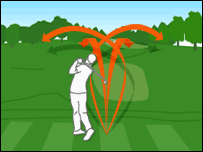 Natural quirks in a golfer's swing will mean the ball might move slightly left or slightly right through the air. Natural quirks in a golfer's swing will mean the ball might move slightly left or slightly right through the air.
Golfers such as Colin Montgomerie learn to use this to their advantage but also learn how to move the ball in other ways. Our troubleshooting guide will tell you why the ball is moving in a certain flight path and golf coach, Nick Bradley, will tell you how to correct it.
Click through the links on the right hand side. You can also check our guides on the basic set up and how to swing the club. ************************************************************************************************ The ball starts to the left of the target line and then curves right to finish to the right of the target.
Check this list of possibilities to see where you are going wrong:
Aim: Your clubface could be too open.
Grip: Your hands may be twisted too far round to the left of the grip, known as a weak grip. As you swing through the ball the blade is naturally opening.
Ball position: The ball could be too far forward in your stance causing your shoulders to open.
Stance: Your stance may be too narrow causing you to be unstable and rely too much on your arms through the forward swing rather than your hips.
Body alignment: Your feet, hips and shoulders are probably aiming too far left of the target causing you to swing your club on an 'out to in' swing path. (See above).
Posture: You may be standing too far from the ball.
Swing: In the first part of the backswing the club goes too much to the inside. The left arm goes too much across the chest. The arms have got nowhere to go so they lift and go over the top, like a figure of eight almost. (See above).
Golf coach tip: Hit shots from a side hill lie with the ball above your feet. This will get you swinging along the correct target line rather than in, up and over. ************************************************************************************************ The ball starts to the left of the target line and continues to fly straight along that line. This of 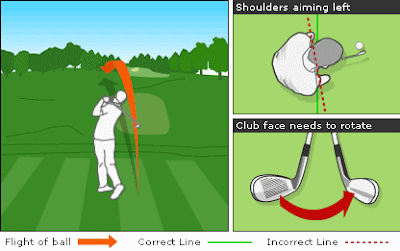 ten happens with short irons. ten happens with short irons.
Check this list of possibilities to see where you are going wrong:
Aim: Clubface not normally a factor.
Grip: Both hands could be twisted too far round the right on the grip causing the clubface to close at impact.
Ball position: The ball may be too far forward in the stance causing the shoulders to aim left.
Stance: If the stance is too narrow the shoulders will dominate the forward swing.
Body alignment: The feet, hips and shoulders are aiming too far left. (See above).
Posture: Maybe a bit top heavy where you don't have enough knee flex.
Arms: Your arms are too close to your chest.
Golf coach tip: Check your grip and your clubface position, making sure it's not closed. Try and rotate the clubface through the ball like a swing door in a western. Make sure it opens on the way back and closes after you've hit the shot. (See above).
************************************************************************************************
How to fade the ball
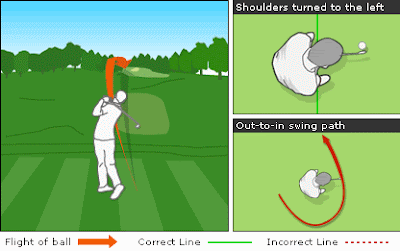 A ball which starts left and moves right through the air ending on target is known as a fade.
A ball which starts left and moves right through the air ending on target is known as a fade.
Colin Montgomerie hits this shot as a natural part of his game.
It's a good thing, here's how to play it:
Step 1: Set your clubface square to the ball.
Hold the club extra tight in the bottom three fingers of your left hand which means you will release the club slightly later than normal and help create the left to right trajectory.
Step 2: Aim your feet and shoulders to the left of the target making sure the clubface is still square. (See above).
Step 3: With everything except the club aiming left, it should automatically force you to develop an out-to-in swing path which is necessary to create the fade. (See above).
Step 4: On the downswing concentrate on bringing the club back across the ball, attacking the 2 o'clock position on the ball. You should feel like your right hand comes underneath the shot.
Golf coach tip: If you're going to commit to fading the ball then start aiming left. Really commit to moving it from left to right.
************************************************************************************************
How to draw the ball
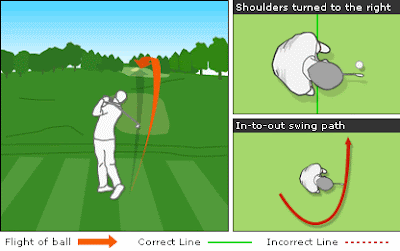 The ball starts to the right of the target line then curves to the left to finish on target.
A draw is a good thing, here's how to play it.
The ball starts to the right of the target line then curves to the left to finish on target.
A draw is a good thing, here's how to play it.
Step 1: Set your clubface square to the ball.
Hold the club more loosely in your left hand turning your grip clockwise so you can see an extra knuckle on your left hand thus creating a stronger grip.
Step 2: Aim your feet and shoulders to the right of the target, making sure the clubface is still square. (See above).
The ball might be slightly further forward in your stance.
Step 3: With everything aiming right of the target except the club head, you should automatically develop an 'in-to-out' swing path. (See above).
Concentrate on swinging the club back along the line of your feet.
Step 4: Fire into the ball on the downswing, visualising hitting through the 4 o'clock position on the ball. It should feel like you are following through well right of the target and that your right hand is turning over your left.
Golf coach tip: It's far easier to draw and shape ball with long irons than with short irons. Don't try and draw a short iron because it will inevitably turn into a hook.
************************************************************************************************
Get rid of the push shot
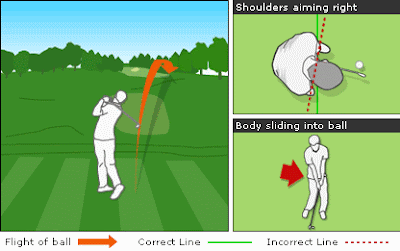 The ball starts to the right of target line and continues to fly straight along that line.
The ball starts to the right of target line and continues to fly straight along that line.
Check this list of possible faults.
Aim: Clubface not normally a factor.
Grip: Grip a little weak but not usually a factor.
Ball position: The ball position needs to be right so you hit the ball at the bottom of the swing arc. Ball likely to be too far back causing you to block the shot.
Stance: It may be too wide restricting the weight transference on the forward swing.
Body alignment: The feet, hips and shoulders may be aiming too far to the right. (See above).
Posture: You may be sitting too far back on your heels. Put your weight on to your toes more.
Swing: The body may well be sliding into the ball rather than turning through the shot. This means you are unlikely to be turning your hips as you should. (See above).
Golf coach tip: At the driving range, stand at the far right bay and hit to the left of the range. You won't push it.
************************************************************************************************
How to avoid hooking the ball
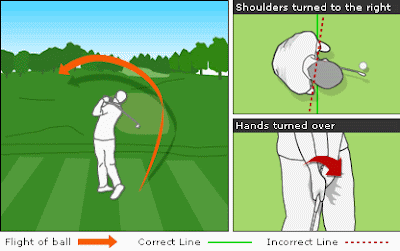 The ball starts to the right of the target line and then curves to the left to finish to the left of the target.
Check the following list for possible faults:
Aim: Your clubface may be too closed.
The ball starts to the right of the target line and then curves to the left to finish to the left of the target.
Check the following list for possible faults:
Aim: Your clubface may be too closed.
Grip: One or both of your hands may be twisted too far to the right. Check the V formed by your thumb and forefinger - it should be pointing inside your right shoulder, not outside.
Ball position: The ball may be too far back in the stance.
Stance: Not usually a problem but may be too wide.
Body alignment: Shoulders aimed far too far to the right. (See above).
Posture: Not normally a factor.
Swing: You cannot hook the ball unless your clubface is going crazy through the strike. Generally the swing is too long so, the body gets to the ball before the club head and the hands turn over at the last minute. (See above).
Golf coach tip: Keep the swing nice and short.
|